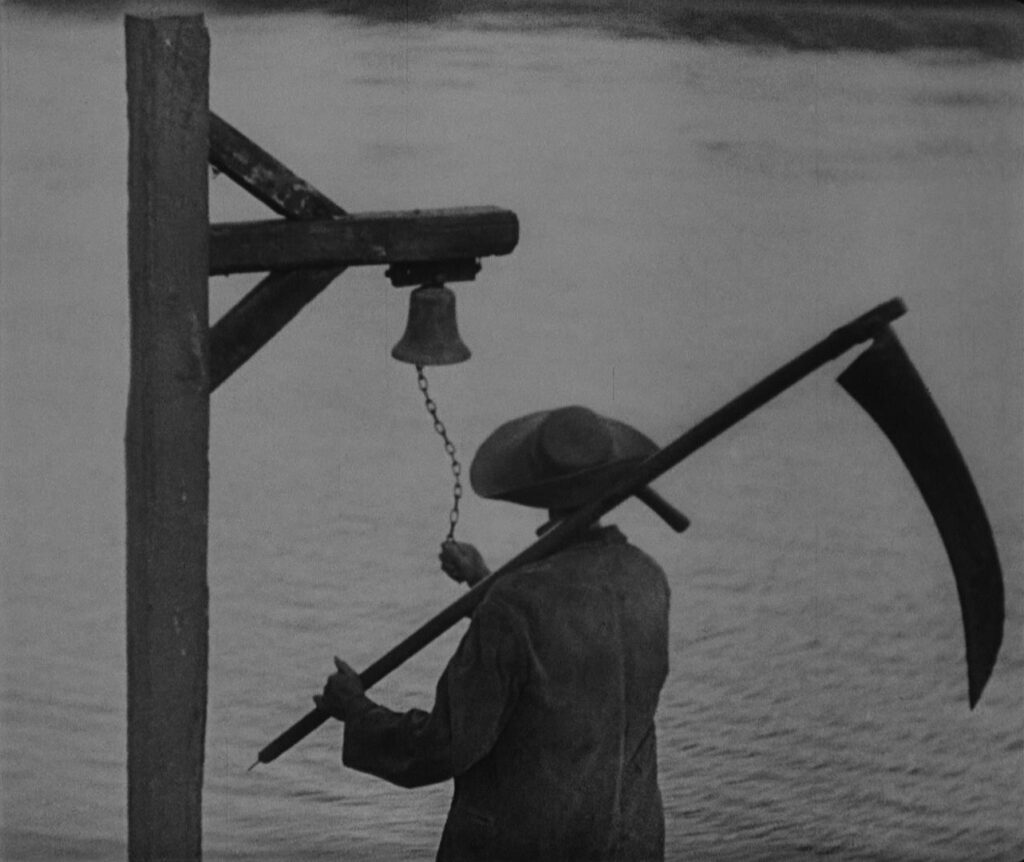
Vampyr
1932, directed by Carl Theodor Dreyer
The preface to Vampyr introduces Allan Gray as a young man wandering aimlessly through life, dabbling in the occult, lost in confusion between reality and the supernatural. For the next twenty minutes, before Allan arrives at the chateau in Courtempierre, premonitions of death appear all around him – a reaper, a ferryman, a gravedigger, ghostly shadows, a vampire, a bottle of poison. A mysterious old man enters Allan’s room at the inn with a cryptic message: “She mustn’t die, do you hear?” We see images of a skull, a spider web, an angel, a skeleton, an hourglass, a cross, a pendulum, and a coffin. The spooky setting has the earmarks of a ghost story, which is not surprising in a film inspired by two pieces by Sheridan le Fanu, a famous 19th century ghost story writer.
Connoisseurs of German silent film may notice a few parallels to The Cabinet of Dr. Caligari. The vampire’s assistants are a doctor and a soldier, recalling the sinister team of Dr. Caligari and Cesare, the latter named for a military figure. Both films open old books to reveal legends that explain some of what’s happening. Hermann Warm was art director on both movies, and both feature a character named Alan or Allan. Caligari had begun with a ghost story, at least a fragment of one, when the old man told Francis of the omnipresent spirits who had so upset his life. In spite of its macabre atmosphere however, The Cabinet of Dr. Caligari quickly abandons all reference to the supernatural. Francis counters the old man with his own story, a journey into the unconscious that proves more cinematic than the evident literary roots of the old man’s ghost tale.
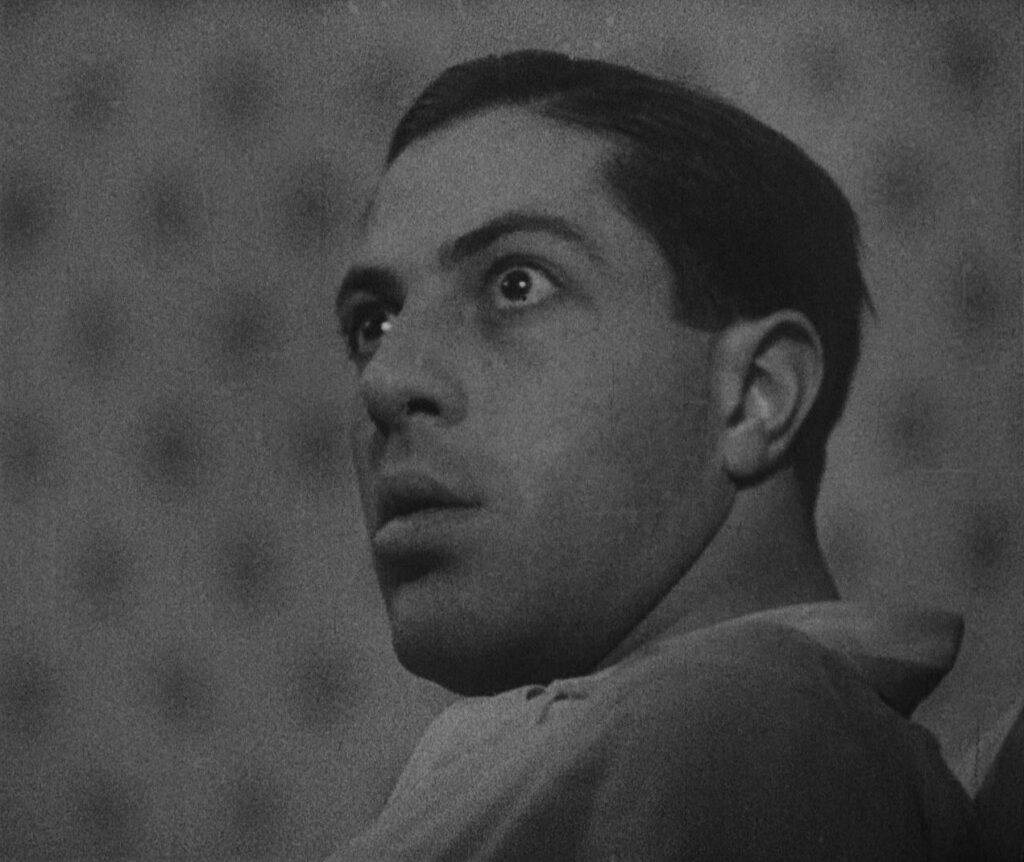
Vampyr is outwardly more like the old man’s supernatural tale than Francis’s more modern narrative, but it should not be mistaken for a regression to the romantic fiction of the 19th century. The opening description of Allan’s aimlessness and confusion tips us off that he won’t remain in that state for too long. Like Caligari, Vampyr opposes its own ghostly opening with a realistic understanding of life. The movie never abandons its supernatural premise, but it does renounce the romanticism that seeks out the supernatural as an escape from reality.
The movie falls into roughly three sections of increasing length. In the opening act Allan Gray inhabits a fantasy world filled with omens of death. He has chosen this world, and guided by curiosity he follows spectral shadows outside the inn to the old doctor’s house where he first sees the vampire, an old woman named Marguerite Chopin. Throughout Gray’s wanderings he remains an observer of the spooky apparitions around him. He feels an occasional frisson of terror, but nothing touches him, and he does not engage with the spirit world beyond a few words with the doctor.
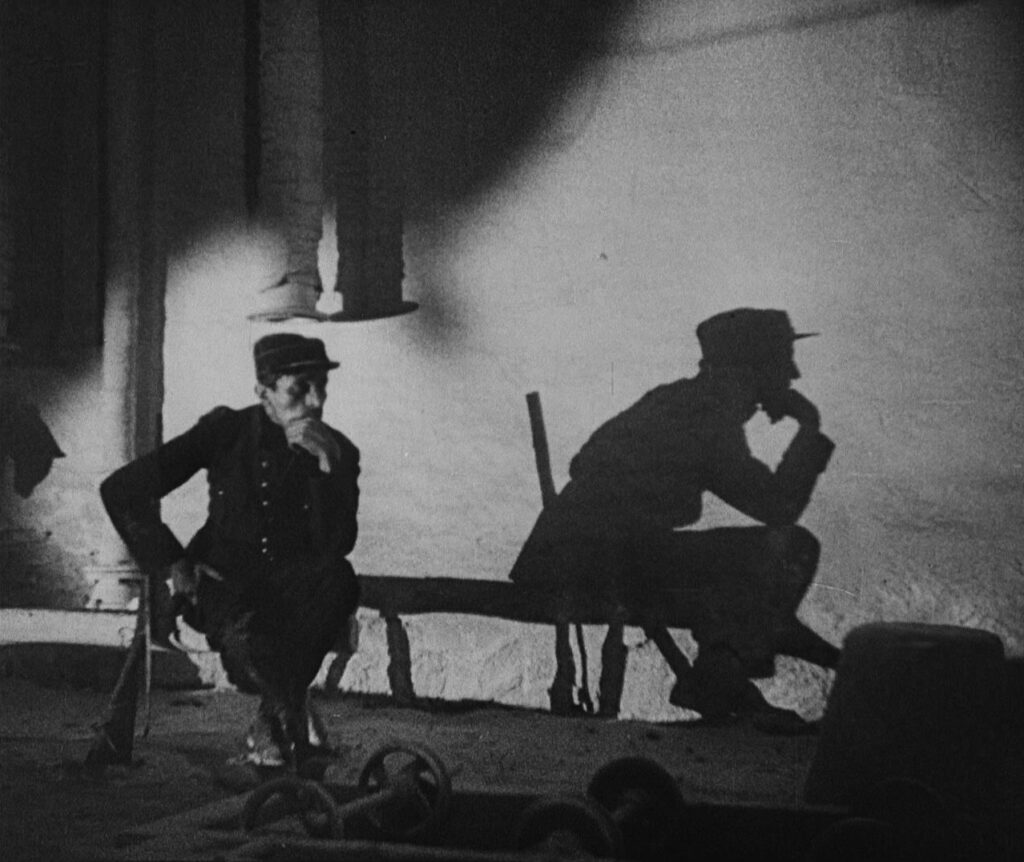
Things get serious, however, as soon as Allan Gray arrives at the chateau. The eerie tokens of death he had been pursuing now give way to real deaths. The shadowy rifleman fatally shoots the chateau’s lord, the same old man who had startled Gray at the inn. A coachman goes to fetch the police, but the coach returns with its driver dead. The lord’s elder daughter Léone wanders from her sickbed into the garden where the vampire bites her neck.
Gray’s boyish fascination with the occult leaves him ill prepared for this sustained attack of the spirit world upon the living. At the shooting he can only watch helplessly, act alarmed, rap on the window to alert the servant, and give the dying lord a few spoonfuls of tea. He follows Giséle around, feebly trying to play a hero. He and Giséle follow Léone into the garden to stare at the horrific scene, approaching Léone only after the vampire slinks off. Allan stands by idly while the elderly servant and nurse retrieve Léone, and he lets the two servants handle the dead coachman.
Throughout this second phase Allan remains as passive as he had been in the first. The third phase begins when the doctor urges him to donate blood for Léone, but he hesitates for a full minute. “She needs blood,” the doctor tells him, but Allan turns and walks toward Léone. “Human blood,” the doctor calls out. Allan keeps walking. “Are you willing to give her your own?” Allan turns to face the doctor’s piercing stare, as if shocked by the suggestion. He turns to Léone once more. “Come, young man. I’ll draw your blood.” At this point Allan can hardly say no. It would seem that he’s just as passive as ever, but the act of giving blood is too symbolic to be taken as totally passive in a movie. It represents self-sacrifice, a gift from deep inside. Allan gives the transfusion too reluctantly for the act to suffice for his transformation, but the symbolic act soon turns into real action when he boldy pushes the doctor away from Léone and snatches poison from her hand. The doctor runs away – Allan has saved Léone from suicide.
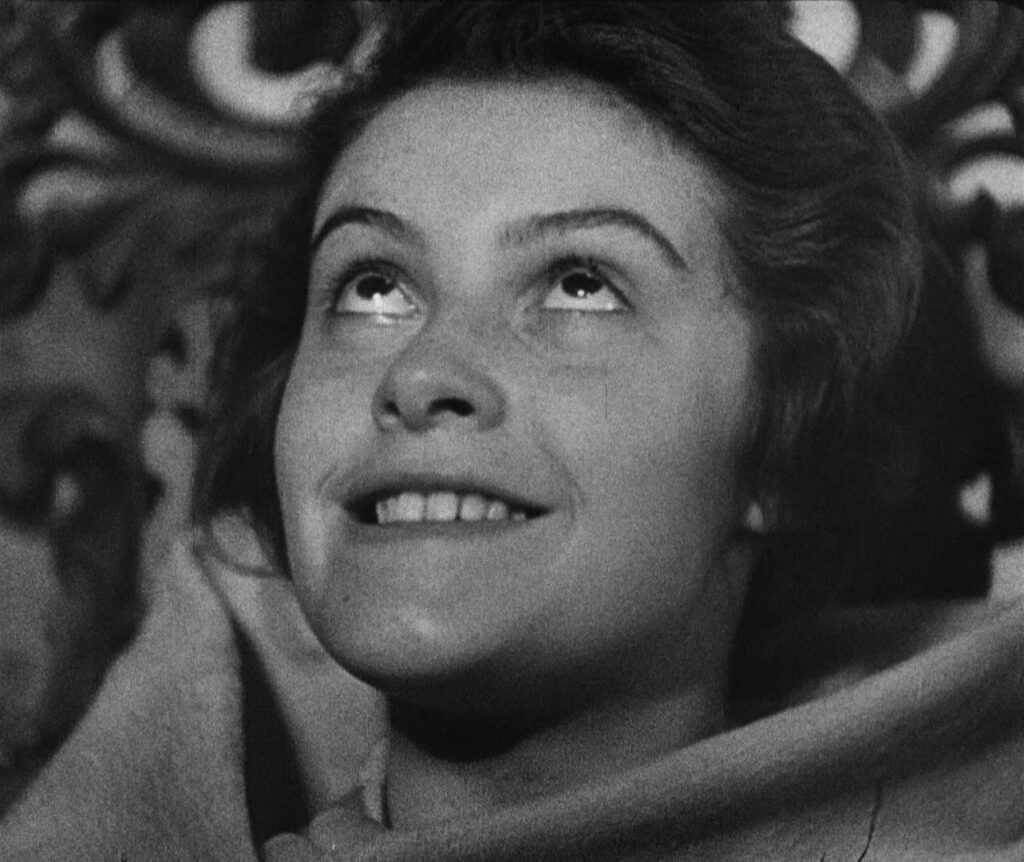
It might seem confusing for a doctor so insistent on saving Léone’s life one minute to encourage her suicide in the next, but a page from a history of vampires is intercut to explain this apparent plot hole. The doctor, acting on Marguerite Chopin’s behalf, does not actually wish to save Léone – he merely wants to keep her alive long enough to commit the mortal sin of suicide, thus delivering her soul to the devil.
After defending Léone, Allan chases the doctor outside, but he falls down and passes out. A double exposure depicts his dream self leaving his sleeping body, and he is reduplicated once more when the dreamer finds his own body in a coffin. These doublings hold a figurative mirror to Allan Gray. In the film’s most famous sequence Allan’s point of view switches to his body in the coffin, watching helplessly through a small window as the lid is fixed tight and pallbearers carry him to the churchyard for burial. This ride inside the coffin is a metaphor for his life up to now. His passivity was a living death.
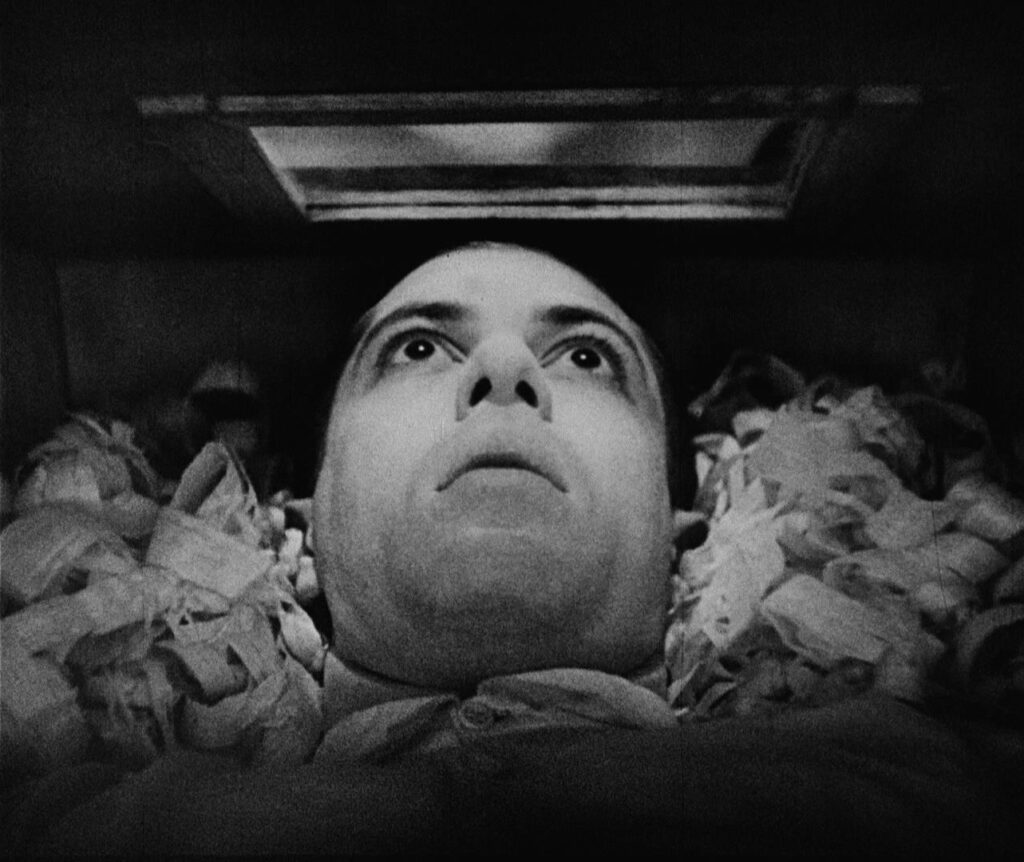
Upon waking Allan immediately goes to the churchyard to assist the head servant in opening Marguerite Chopin’s grave and driving an iron stake through her heart, putting an end to the vampire’s terror. Next, guided by the memory of his dream, he goes to the doctor’s house, unties the kidnapped Giséle, and escapes with her across the foggy lake where the ferryman guides them to shore. At last he has shed his passivity and taken part in the world around him, no longer guided by a romantic fascination with the otherworldly.
Active participation in the world does not mean acting like a hero. Allan Gray may snatch poison from Léone and free Gisèle, but it’s important that it’s a servant who kills the vampire. Allan merely serves the servant, helping to pass boards and a stake over the edge of her grave. Likewise, it’s not Allan but the ghost of the old lord who punishes the soldier and the doctor. In the real world, heroic deeds are acts of service to be performed humbly, and vengeance is not the prerogative of the living.
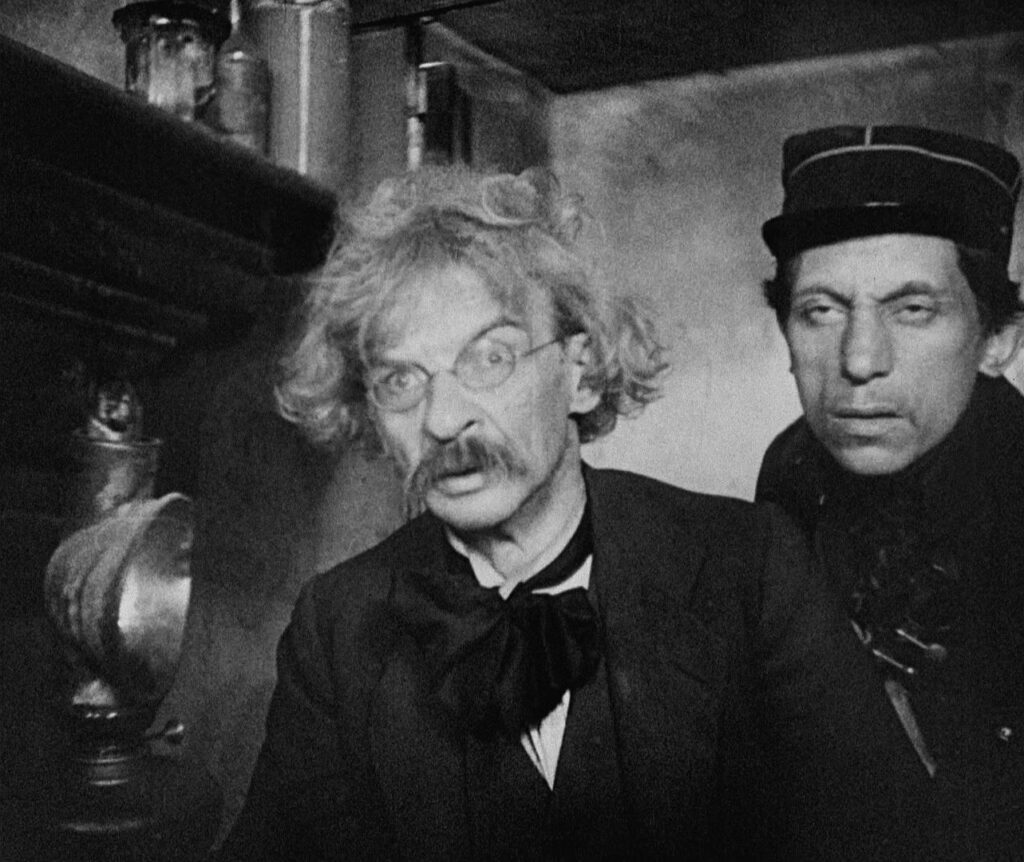
Marguerite Chopin’s two assistants, a doctor and a soldier, stand for knowledge and power, which are so often corrupted into assisting the everyday vampirism that drains life of meaning when people live as passively as Allan Gray. We’re meant to appreciate that the wandering protagonist is not some exceptional character, but rather a stand-in for all of us, who may be vulnerable at times to the same morbid fascinations. It’s remarkable how much the doctor counts on Allan’s passivity, and how easily he’s dispatched once Allan gathers a bit of courage.
Vampyr‘s argument against romanticism is inseparable from its call for active engagement in life. Romanticism is strongly associated with art, so that Allan Gray implicitly plays the role of an artist, not least of all like Dreyer himself who was always drawn by temperament to the supernatural. The metaphor of blood in the title and in the plot is doubly significant. Like Allan Gray, an artist must “give blood” as opposed to standing aloof from life. Conversely, the artist must not be seduced by romantic visions of “art for art’s sake”. When art is elevated above life it becomes a bloodless abstraction, as if sucked dry by a vampire. The artist’s proper role is to restore life, to rescue people from the damnation of a living death.
CONNECTIONS:
The Cabinet of Dr. Caligari – Sinister doctor and soldier (or character with a military name); Hermann Warm as art director; Alan/Allan; garden benches; explanation in old books; opening that resembles a ghost story
The Blood of a Poet – Metaphor of blood for an artist’s sacrifice in connecting art to life
L’Atalante – Argument that art should connect people to life
Day of Wrath – Supernatural horror (vampires, witchcraft) as a metaphor for a real-world problem
Orphée – Death as a metaphor for art detached from life
Diary of a Country Priest – Symbolism of a doctor and a soldier
Ugetsu monogatari – Adaptation from two separate short stories
Cléo from 5 to 7 – Protagonist transforms from passive to active upon giving something (blood/hat) away
Vivre sa vie – Argument that art for art’s sake drains life from the living
Pierrot le fou – Link between art and death
Andrei Rublev – Argument against art as something aloof from earthly matters
The Double Life of Veronique – Point of view from a corpse lying in a coffin; commentary on artistic creation
The Wind Will Carry Us – Recurring images of death
Get Out – Immobile character views the world through a small rectangular window above him
The House That Jack Built – Implied link between art and death
LIST OF SIGNS OF DEATH IN THE OPENING SCENES:
- the skull under the opening credits
- the spider web under the introductory text
- the butterfly net Allan carries
- the angel over the hotel sign
- the reaper with his scythe
- the ferryman
- the picture of a skeleton on the hotel room wall
- the blind man in the hotel
- the hourglass under the intertitle
- the old man who enters Allan’s room and says “She mustn’t die, do you hear?”
- the message on the parcel: “To be opened after my death”
- the cross under the intertitle
- the ghostly figure reflected in the canal
- the shadow of the gravedigger played in reverse
- the independent shadow of the one-legged soldier
- the vampire
- the shadow of the pendulum
- the shadows of ghostly figures dancing and playing music
- the coffin on the floor
- the skulls and skeletons in the doctor’s office
- the empty shell of a grandfather clock
- the doctor walking like a somnambulist
- the bottle of poison with a skull and crossbones